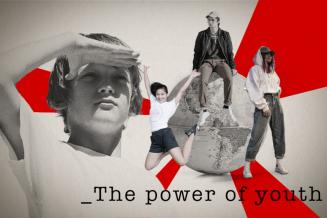Promoting tolerance, human dignity and fundamental human rights

Eradicating systemic racism and nurturing cultural diversity and discrimination : The long-lasting dream
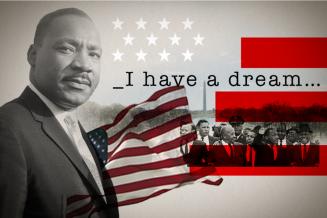
I have a dream that one day this nation will rise up and live out the true meaning of its creed: We hold these truths to be self-evident, that all men are created equal.
The address that Martin Luther King Jr. delivered on the steps of the Lincoln Memorial in Washington D.C. on 28 August 1963 is considered as one of the most inspirational speeches ever written.
With these powerful words, the American civil rights activist evoked his dream that all people – of all races and backgrounds – would live together in a community marked by freedom and democracy.
Martin Luther King pointed out how the ignorance of the other engenders conflicts and that equality between individuals is necessary to build a nation of peace.
He also emphasized the actions and aspirations and the importance of cooperation among individuals within a framework of tolerance and integration – the same fundamental values that UNESCO has been pursuing since its inception in 1945.
Five years later, in 1950, UNESCO published a revolutionary statement on racial equality that was unprecedented as a declaration by an official public body. The Statement on Race asserted that there was no scientific basis for racial bias and that biology proved the "universal brotherhood of man."
UNESCO’s unprecedented statement had major consequences and influenced the US Supreme Court decision of 1954 that declared the separation of schools for Afrodescendants and white students unconstitutional.
It also formed the basis of the UNESCO series of books titled The Race Question, written by major 20th century scientists and intellectuals, which had a resounding impact worldwide, leading to the withdrawal of apartheid South Africa from the organization in 1955.
Over the years, UNESCO has published further statements on race to advance its goals of advocating human equality and has adapted its communication by widening its message. The fight against racism and discrimination has been transformed with the International Coalition of Inclusive and Sustainable Cities, the Master Class Series against Racism and Discriminations, as well as partnerships with major football clubs in Europe.
In 2021, UNESCO held the first Global Forum against Racism and Discrimination.
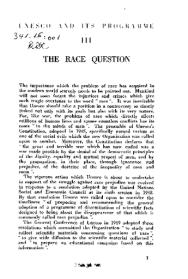
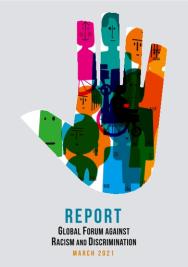
Our own histories: The General History of Humanity

Besides millions of deaths, World War II left in its wake a world wounded in its humanity.
The enormity of this disaster compelled the international community to build the defences of peace. UNESCO was created to make this commitment a reality, with the aim to establish lasting, genuine peace by fighting ignorance in favour of mutual understanding through education, culture and the sciences.
That’s why the idea of analyzing the entire history of humanity began to take shape. It was the first project undertaken by UNESCO and would become its most enduring, spanning more than half a century.
The General History of Humanity was created by people writing their own history. Instead of just tracing the past of nations, it aims to provide a greater understanding of civilizations.
The world's memory is composed of more than just kings, battles and conquests. Through a different perspective of cultures and populations, these collections, written by local historians, show people's consciousness and how they shape their own destiny.
For the first time, history showed the point of view of the populations concerned, whose past had often been distorted, discredited or treated as peripheral to the history of the colonisers and the dominant nations.
Launched in 1952, this endeavour generated 51 volumes of history in six different collections: The History of Humanity, the General History of Africa, the History of the Civilizations of Central Asia, the General History of Latin America, the General History of the Caribbean and the Different Aspects of the Islamic Culture.
Mobilizing more than 1800 historians and experts from all regions of the world, this vast enterprise introduced a new understanding of human history by highlighting the exchanges between peoples and cultures and their respective contributions to the general progress of humanity.
The Statement on Race and the General History of Humanity were the cornerstones of UNESCO’s goal to defend human dignity across its activities.
From the right to education and the right to science, to the right to cultural diversity and the right to freedom of expression, fundamental human rights are both the universal expression of the values and ideals around which UNESCO is united. Throughout the years, they have remained and continue to be a mainstay of its missions.

Fighting racism through education, breaking the wall of silence: The Slave Route

Millions of Africans are scattered throughout the world today. Many are the descendants of the people who were torn away from their lands over 1500 years of slave trade. What are their stories? What did they contribute to global culture? And why don't we know more about their stories?
The concept of race took hold in 15th century Europe, when theories of racial hierarchy – especially the congenital inferiority of Afrodescendants – began to spread. Africans were said to have no history, no culture, no civilization.
Despite the violent, oppressive way in which Africans were forced to leave their birthplace, they became the first globalized people, creating human and cultural links with Asia, the Middle East, Europe and all of the Americas.
For Africans and their descendants, knowing their own history means celebrating their shared heritage and better preparing for the future.
Those who forget or deny their history are indeed doomed to repeat the slave trades that literally changed the face of the world.
Aware that ignoring key historic events can be an obstacle to peace and mutual understanding, UNESCO decided to break silence on the slave trade and slavery.
In 1994, it supported the Slave Route Project to highlight the importance of knowing the history and processes that have shaped and legitimized slavery.
Central to the work we do are our efforts to broaden awareness of the multiple causes and modalities surrounding the transatlantic slave trade, as well as slavery in the Indian Ocean and the Mediterranean.
We can understand the major contemporary challenges of the fight against racism and all forms of discrimination only if we are aware of the history of people of African descent.
Since its launch, the Slave Route Project has contributed to the production of innovative knowledge, the development of high-level scientific networks and the support of memory initiatives on the theme of slavery, its abolition and the resistance it generated.
It has done so through various activities, including scientific research, the publication of reference books, the development of educational materials, the inventory of sites of memorial sites, the promotion of living cultures and the preservation of archives and oral traditions related to this history.
The project also played a crucial role in the recognition of the slave trade and slavery as "crime against Humanity" during the World Conference against Racism held in Durban, South Africa, in 2001.
By understanding this silent chapter of world history, humanity can better grasp the genealogy linking the slave trade to other crimes against humanity and new forms of enslavement.
Spearhead of cultural exchange and diversity, the long, eastward route: Silk Roads.
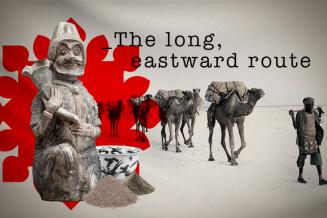
Africa was not the only continent to witness flows of people to faraway lands.
The Silk Road was the first international commercial route that connected two powerful empires: China, the only producer of silk, and the Romans, who clamoured to dress in the rare fabric from afar. It created a vast trading network across Central Asia and India that ended up carrying more than silk, exotic spices and precious gems.
The constant flow of people along the routes carried knowledge, ideas, cultures and beliefs, which had a profound impact on the history and civilizations of the Eurasian people. Travellers along the Silk Road found not just goods to trade, but also intellectual and cultural exchange within the cities along the route, which developed into hubs of culture and learning.
In the steppes of Kazakhstan’s southwestern region, the ancient city of Kulan thrived as a key hub on the Chang’an-Tianshan corridor of the Silk Road. Caravans of merchants and travellers carried new knowledge and goods across thousands of kilometres between the 2nd century BC to the 16th century AD.
Trade had a profound influence on how the landscape developed into towns and cities, bringing together nomadic and settled communities. Water management systems as well as a network of forts, beacon towers, way stations and caravanserai accommodated travellers and ensured their safety. Buddhist shrines and cave temples – as well as manifestations of other religions such as Zoroastrianism, Manichaeism, Nestorian Christianity and Islam –reflected the cosmopolitan, multi-ethnic communities that organised and benefitted from the trade in precious commodities.
In the Middle Ages, there used to be over 70 cities and towns in the Jambyl area. They were a sign of spiritual and cultural civilization. According to data from that time, Kulan used to be a huge city, where the elites came from.
The fascinating history of Kulan is just one among the thousands of hubs that coasted the Silk Road and its constant flow of trade and culture exchange.
Since 1988, UNESCO has sought to better understand the rich history and shared legacy of the historic Silk Roads and the ways in which cultures have mutually influenced each other.
To keep alive the enduring legacy of the Silk Roads in connecting civilizations throughout history, the Silk Roads Programme revives and extends these historic networks in a digital space, bringing people together in an ongoing dialogue and fostering a mutual understanding of the diverse and often inter-related cultures that have developed and thrived around these routes.
Youth empowerment and development : the power of young people to change the world.
Just as the Silk Road connected far-flung communities through trade and culture, today’s youths are reaching out to each other to solve the problems that the Covid-19 pandemic has exposed and exacerbated, particularly in less developed countries.
Many young people feel anxious and unsure of how to deal with the inequalities they see in society.
We have seen things in Covid-19 like mental health, depression and the marginalization of certain groups in society that are quite terrifying. The world is putting exploitation, inequality and marginalization at the centre of decisions.
The pandemic also brought unprecedented educational disruption with 1.2 billion children and youth impacted by school closures.
UNESCO’s Youth As Researchers (YAR) global initiative on COVID-19 connects and engages with young people to conduct research on the impacts of COVID-19 on young people and the responses young people have implemented to tackle these challenges.
Young people between the ages of 18 and 35 have formed research teams that seek to answer these and other questions. This research is designed by young people, conducted by young people and about young people.
Launched in 2020, the initiative is the largest youth-led capacity building project in response to COVID-19 in the world, engaging 270 young people from over 70 countries as youth researchers, with an additional 10,000 in efforts to support 34 global, regional and national research teams.
Young people have a voice to share and want to be a part of the changes impacting their communities.
Connecting urban communities through cultural exchange and creativity
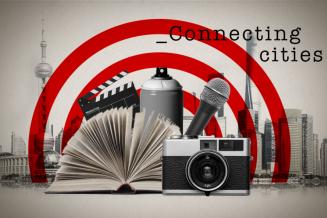
But communities don’t thrive in a void, or when they are disconnected from each other. Today, half of the world’s population lives in cities. This rapid urbanisation process has raised many consequences for our societies at many levels – social, economic, environmental and cultural.
In response, city communities have begun strengthening their creative and entrepreneurial potential, increasing use of social media digital technologies and boost cultural diversity as well as build new bridges for global cooperation.
Culture makes people united, it makes people proud and it also develops the city’s economy. That’s why we should be creative and proud to be citizens.
Since 2004, UNESCO has been encouraging cities to share their experience in seven fields of creative industries: literature, film, music, crafts and folk art, design, media arts and gastronomy.
The UNESCO Creative Cities Network (UCCN) is a global platform that aims to give visibility to member cities and encourages them to set up international partnerships in creative industries to support sustainable urban development.
The 246 cities that make up the network work together towards a common objective: placing creativity and cultural industries at the heart of their development plans at the local level and cooperating actively at the international level.
By working closely together, having confidence in each other, benefiting from our respective experiences, we intend to innovate and change the world. People ask themselves whether it’s possible to change the world. I reverse the question: Do we have the choice not to change the world?
The world has changed since the dark days of World War II. But how much? And what needs to be done in the future?
In his speech, Martin Luther King Jr. wished that his four children would not be judged by the colour of their skin, but by their character.
Continuing his legacy of human rights activism, his eldest son, Martin Luther King III, acknowledges that humanity needs to continue to strive to achieve his father’s dream of equality and integration.
Every generation needs to sustain the progress that has been made so far. You can never sit down and relax. We have to fight for what is good, just and right. We are seeing change all over the world. It’s far too slow, but it’s happening. And as people become more conscious and become more engaged, we will see these changes manifest in a permanent way that moves our society forward.
The Ethics of Artificial Intelligence
Artificial intelligence has become a pervasive component of our daily life, enabling us to book flights, ask our phones to read the news, turn on the central heating while we are away. In highly specialized fields, it has become indispensable for cancer screening and building inclusive environments for people with disabilities. But it is bringing new unprecedented challenges, such as gender and ethnic bias, significant threats to privacy and angers of mass surveillance.
Thanks to the mobilization of hundreds of experts from around the world, UNESCO’s 193 member states have just officially adopted an ethical framework for artificial intelligence.
UNESCO Inclusive Policy Lab
The UNESCO Inclusive Policy Lab focuses on knowledge crowdsourcing and its translation into inequality-reducing policies. It operates through an online platform and a network of in-country projects.
The online platform comprises 3,300 members, 1,500 experts, and 100 online collaborative spaces. It is a leading platform of its kind, combining decentralized generation of data and consolidation of key trends.
These Lab’s impact-oriented projects expand the boundaries of knowledge and its impact on inclusive policies.
International Day of Sport for Development and Peace
Sport has historically played an important role in all societies, be it in the form of competitive sport, physical activity or leisure. It is a powerful vehicle for social inclusion, gender equality and youth empowerment. To promote sport as an impact tool, in 2013 the UN General Assembly made the decision to proclaim 6 April as the International Day of Sport for Development and Peace.


